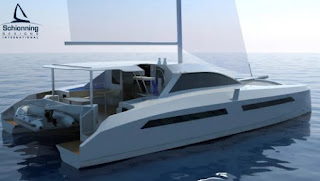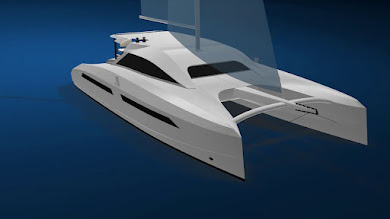 Back in April, I made a Blog post about different hybrid propulsion systems, and how we chose a parallel system for the comfortable production catamaran we planned to purchase, used. Times have changed. Used cat prices went through the roof, so we decided to build a catamaran, ourselves! We are in the process of constructing a new 50' performance catamaran. With that change in the type of boat we will sail around the planet, we had to re-evaluate which propulsion system would best suit this new performance cat.
Back in April, I made a Blog post about different hybrid propulsion systems, and how we chose a parallel system for the comfortable production catamaran we planned to purchase, used. Times have changed. Used cat prices went through the roof, so we decided to build a catamaran, ourselves! We are in the process of constructing a new 50' performance catamaran. With that change in the type of boat we will sail around the planet, we had to re-evaluate which propulsion system would best suit this new performance cat.
We talked to a lot of boat owners and found one captain who owned a 50' performance catamaran, who circumnavigated using a combination parallel and electric Motor system. He swore that it was the way to go. We found that to be intriguing since we also plan to circumnavigate on a 50' performance catamaran. So, we ran all the numbers to find out if this might be a better choice than a pure Parallel propulsion system for a performance catamaran.
Before we get to the results, let's discuss why we had to re-evaluate now that we are going to sail a performance cat. The difference is load carrying capacity. A performance cat is only fast if you keep them light enough. Otherwise, you sink the narrow hulls lower in the water and lose all your performance.So, before we compared other things, we looked at weight since this was a critical element for our new style of cat.
For a parallel propulsion system, here is a simple weight calculation. A 55hp Yanmar, with gear, weighs 573 pounds. A 25 kw parallel motor weighs 150 pounds. So, we have to double that weight since there is one set in each hull. The total came out to 1446 pounds.That means, we shave off 531 pounds if we use a combination Parallel/Electric system. That's a big weight savings!
But what about horsepower? Well, the combination has 110hp, maximum (55hp from each diesel). The parallel has 80hp from the diesel and 34hp (25 kw equivalent) from the electric. That is a total of 114hp, virtually the same as the parallel system, so no advantage to either one.
Both systems have redundancy as the diesels or electric motors may be run separately. And, though it is true the parallel system would have a redundant diesel engine, the combo still has a second propulsion system so that is enough backup for our needs. And, remember, we are a sail boat, so there is a third propulsion system, wind and sails.
So what about price? On the parallel options, two 55hp diesels from Nanni cost about $12,000 each. The parallel system for each runs about $15,000. Total, in round numbers, about $54,000
On the combination parallel/electric option, we have one Nanni 80 hp diesel that runs about $14,000, plus one parallel electric motor for $15,000. Then, in the opposite hull we have a single electric motor that runs about $12,000. All total, $41,000.
As you can see, we save about $13,000 dollars!
In fuel efficiency, our calculations show them to be very similar, though a boat weighing less will save us a bit of fuel with the combination system.



























